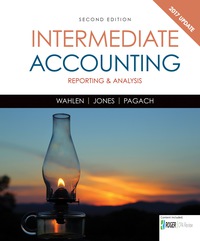






The Inglis University Library donations department is operated by the head librarian, Asenath James, and a graduate assistant, Randolph Carter, a folklore student at Inglis University. The head librarian is a salaried position ($48,000 per year), and since Asenath currently spends approximately one-quarter of her time soliciting and processing book donations, one-fourth of her contracted annual base salary ($12,000) is allocated to the book donations department. The Inglis University Library is also allotted $5,200 per academic year in additional funds to support the library donations function. This meager sum is used to provide a graduate work-study student a stipend to assist Asenath in the donations department during the fall and spring semesters. Work-study students typically work 20 hours per week and are paid on an hourly basis at a rate of $10 per hour. A typical semester is 13 weeks long. Currently, Randolph is working all his allotted hours in the book donations department. If he were not fully utilized by the book donations department, he would work elsewhere in the university, as his work hours and stipend are guaranteed as a part of his fiancial aid program. In addition, the library has allotted a small space in the basement of its main building for donations activities. The library allocates a portion of the library's general facilities costs ($1,200 per year). General facility costs include depreciation on the building, property taxes, insurance, general maintenance costs, and utilities. Typically, Asenath and her assistant solicit and process an average of 1,000 books per academic year and can, without too much difficulty, solicit and process up to 1,200 books per academic year. However, each year for the past five years, the number of books donated and processed for the library has increased noticeably. Unfortunately, Asenath, as head librarian, has library duties other than donations and cannot devote any additional time to the donations department. Randolph's current work-study contract is restricted to only 20 hours per week and only applies to the fall and spring semester. Asenath has no additional help during the summer months, which creates quite a backlog of unprocessed books going into the fall semester. Of late, Asenath and Randolph have begun to experience difficulty processing the increasing number of book donations, and some recent acquisitions are still sitting in boxes on the floor of the donations department's basement space. Consequently, the library has approached the university budget committee with a request to increase the one graduate Student position (13 weeks @ 20 hours per week which equals 260 hours per semester at $10 per hour equates to $2,600 each semester or $5,250 per year). By including funds allotted to the book donations department by $5,000 per year. These additional funds would be used to employ part-time students to work an additional ten hours per week during the fall and spring semester, and to work 20 hours per week during the summer months to compensate for the increasing number of donated books. This would increase the department's annual capacity to approximately 1,900 books. Asenath can handle the workload between semesters and during the holiday breaks herself with no additional help. Using the cost information provided by the library, the budget committee computed a unit cost per book of $18.90, calculated as follows: Librarian salary allocation $12,000 Graduate assistant stipend $5,200 Facility cost allocation $1,206 3 Total costs $18,400 Per book (based on 1,000 books) $18.40 RFID tag per book $.50 Total unit cost $18.90 The committee has since denied the request for additional funds and expressed the following sentiments. "First, the unit cost of $18.90 per donated book is already too high; an additional $5,000 per year would bring the cost per book to $23.90 per book, an entirely unacceptable cost for the processing of an old used book. Librarian salary allocation $12,000 Graduate assistant stipend $5,200 Facility cost allocation $1,200 Part-time student help $5,000 Total costs $23,400 Per book (based on 1,000 books) $23.40 RFID tag per book $.50 Total unit cost $23.90 "Second, at the already-high cost of $18.90 per book, the library can hardly afford to accept more than 1,000 books per year; if, for instance, the library were to accept 2,000 books, it would cost the university $37,800. Finally, we have serious doubts as to the value of the donations department; if it were eliminated entirely, the university could save, at the very least $23,900 per year. These savings could be used to support some other, more Worthwhile function within the library. Librarian salary allocation $12,000 Graduate assistant stipend $5,200 Facility cost allocation $1,200 Part-time student help $5,000 RFID tags ($.50 _ 1,000 books) $500 Total savings $23,900 Indirect > A V > > > 1 3 Activity: Books Donated, Books Processed 4 5 Costs Fixed Variable Direct 6 Librarian Sal. > > 7 Grad. Assist. > > 8 Undergrads. 9 Facilty 10 RED 11 12 Budget Committee Calculation 13 Total Unit Per Unit 14 Librarian Sal. 1,000 15 Grad. Assist 1,000 16 Undergrads. 17 Facilty 1,000 18 RFD 1,000 19 20 21 Used Book Sales (1,000) 1,000 (1.00) 22 (1.00) 23 24 Expansion Calculation 25 Total Unit Per Unit 26 Librarian Sal. 2,000 27 Grad. Assist 2,000 28 Undergrads. 2,000 29 Facilty 2,000 30 RFD 2,000 31 32 33 Used Book Sales 2,000 34 35 6. 3. What is a Unit Cost? Is the Budget Committee's Unit Cost Appropriate? Should Fixed Costs be in the Unit Cost? 00) 00) 4. Your Summary Management Report. t 5. Which course of action do you recommend and why? 6. What was one of the most profound acquisitions by Asenath James and why













